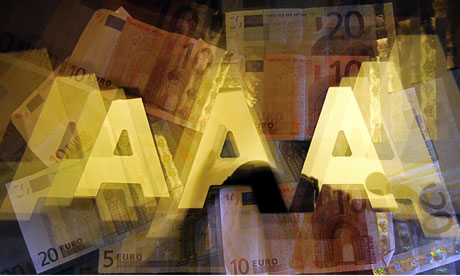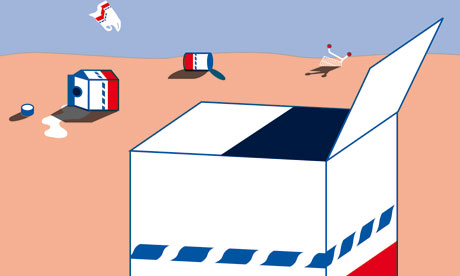Ian Stewart is an Emeritus Professor of Mathematics
at Warwick University and a Fellow of the Royal Society. He has written
over 80 books, mainly popular mathematics, and has won three gold
medals for his work on the public understanding of science. In
collaboration with Terry Pratchett and Jack Cohen he wrote the Science of Discworld series. His new book, 17 Equations That Changed the World, is published by Profile.
Buy 17 Equations That Changed the World from the Guardian bookshop
"'Popular mathematics' may sound like a contradiction in terms. That's what makes the genre so important: we have to change that perception. Mathematics is the Cinderella science: undervalued, underestimated, and misunderstood. Yet it has been one of the main driving forces behind human society for at least three millennia, it powers all of today's technology, and it underpins almost every aspect of our daily lives.
"It's not really surprising that few outside the subject appreciate it, though. School mathematics is so focused on getting the right answer and passing the exam that there is seldom an opportunity to find out what it's all for. The hard core of real mathematics is extremely difficult, and it takes six or seven years to train a research mathematician after they leave school. Popular mathematics provides an entry route for non-specialists. It allows them to appreciate where mathematics came from, who created it, what it's good for, and where it's going, without getting tangled up in the technicalities. It's like listening to music instead of composing it.
"There are many ways to make real mathematics accessible. Its history reveals the subject as a human activity and gives a feel for the broad flow of ideas over the centuries. Biographies of great mathematicians tell us what it's like to work at the frontiers of human knowledge. The great problems, the ones that hit the news media when they are finally solved after centuries of effort, are always fascinating. So are the unsolved ones and the latest hot research areas. The myriad applications of mathematics, from medicine to the iPad, are an almost inexhaustible source of inspiration."
The self-taught Indian genius Srinivasa Ramanujan had a flair for strange and beautiful formulas, so unusual that mathematicians are still coming to grips with their true meaning. He was born into a poor Brahmin family in 1887 and was pursuing original research in his teens. In 1912, he was brought to work at Cambridge. He died of malnutrition and other unknown causes in 1920, leaving a rich legacy that is still not fully understood. There has never been another mathematical life story like it: absolutely riveting.
One of the great cult books, a very original take on the logical paradoxes associated with self-reference, such as "this statement is false". Hofstadter combines the mathematical logic of Kurt Gödel, who proved that some questions in arithmetic can never be answered, with the etchings of Maurits Escher and the music of Bach. Frequent dramatic dialogues between Lewis Carroll's characters Achilles and the Tortoise motivate key topics in a highly original manner, along with their friend Crab who invents the tortoise-chomping record player. DNA and computers get extensive treatment too.
In his long-running Mathematical Games column in Scientific American, Gardner – a journalist with no mathematical training – created the field of recreational mathematics. On the surface his columns were about puzzles and games, but they all concealed mathematical principles, some simple, some surprisingly deep. He combined a playful and clear approach to his subject with a well-developed taste for what was mathematically significant. The book consists of numerous selections from his columns, classified according to the mathematical area involved. Learn how to make a hexaflexagon and why playing Brussels sprouts is a waste of time.
A thoroughly readable account of the meaning of truth in mathematics, presented through a series of quirky adventures in the Greek Islands, the jungles around the Orinoco River, and elsewhere. Examines tricky concepts like infinity, topology, and probability through tall tales and anecdotes. Three different kinds of truth are examined: formal classical logic, the role of the infinite, and inference by plausible reasoning. The story of the student who believed nothing except his calculator is an object lesson for everyone who thinks mathematics is just 'sums'.
In 1852 Francis Guthrie, a young South African mathematician, was attempting to colour the counties in a map of England. Guthrie discovered that he needed only four different colours to ensure that any two adjacent counties had different colours. After some experimentation he convinced himself that the same goes for any map whatsoever. This is the remarkable story of how mathematicians eventually proved he was right, but only with the aid of computers, bringing into question the meaning of "proof". It contains enough detail to be satisfying, but remains accessible and informative throughout.
The classic text What is Mathematics? by Richard Courant and Herbert Robbins focused on the subject's nuts and bolts. It answered its title question by example. Hersh takes a more philosophical view, based on his experience as a professional mathematician. The common working philosophy of most mathematicians is a kind of vague Platonism: mathematical concepts have some sort of independent existence in some ideal world. Although this is what it feels like to insiders, Hersh argues that mathematics is a collective human construct – like money or the Supreme Court. However, it is a construct constrained by its own internal logic; it's not arbitrary. You choose the concepts that interest you, but you don't get to choose how they behave.
Both authors are top-rank mathematicians with years of stage performances behind them, and their speciality is mathematical magic. They show how mathematics relates to juggling and reveal the secrets behind some amazing card tricks. Here's one. The magician mails a pack of cards to anyone, asking them to shuffle it and choose a card. Then he shuffles the cards again, and mails half of them to the magician—not saying whether the chosen card is included. By return mail, the magician names the selected card. No trickery: it all depends on the mathematics of shuffles.
Biologists' understanding of many vital features of the living world, such as sex and survival, depends on the theory of evolution. One of the basic theoretical tools here is the mathematics of game theory, in which several players compete by choosing from a list of possible strategies. The children's game of rock-paper-scissors is a good example. The book illuminates such questions as how genes spread through a population and the evolution of cooperation, by finding the best strategies for games such as cat and mouse, the battle of the sexes, and the prisoner's dilemma. On the borderline between popular science and an academic text, but eminently readable without specialist knowledge.
A collection of 23 science fiction short stories, each of which centres on mathematics. Two are by Martin Gardner, and many of the great writers of SF are represented: Isaac Asimov, Gregory Benford, Larry Niven, Frederik Pohl. The high point is Norman Kagan's utterly hilarious "The Mathenauts", in which only mathematicians can travel through space, because space is mathematical – and, conversely, anything mathematical can be reality. An isomorphomechanism is essential equipment. Between them, these tales cover most of the undergraduate mathematics syllabus, though not in examinable form.
There ought to be a great classic in this top 10, and there is none greater. I've put it last because it's not popularisation in the strict sense. However, it slips in because it communicated to the world one of the very greatest ideas of all time: Nature has laws, and they can be expressed in the language of mathematics. Using nothing more complicated than Euclid's geometry, Newton developed his laws of motion and gravity, applying them to the motion of the planets and strange wobbles in the position of the Moon. He famously said that he "stood on the shoulders of giants", and so he did, but this book set the scientific world alight. As John Maynard Keyes wrote, Newton was a transitional figure of immense stature: "the last of the magicians … the last wonderchild to whom the Magi could do sincere and appropriate homage." No mathematical book has had more impact.
- Seventeen Equations that Changed the World
- by Ian Stewart
-

- Buy it from the Guardian bookshop
- Tell us what you think: Star-rate and review this book
"'Popular mathematics' may sound like a contradiction in terms. That's what makes the genre so important: we have to change that perception. Mathematics is the Cinderella science: undervalued, underestimated, and misunderstood. Yet it has been one of the main driving forces behind human society for at least three millennia, it powers all of today's technology, and it underpins almost every aspect of our daily lives.
"It's not really surprising that few outside the subject appreciate it, though. School mathematics is so focused on getting the right answer and passing the exam that there is seldom an opportunity to find out what it's all for. The hard core of real mathematics is extremely difficult, and it takes six or seven years to train a research mathematician after they leave school. Popular mathematics provides an entry route for non-specialists. It allows them to appreciate where mathematics came from, who created it, what it's good for, and where it's going, without getting tangled up in the technicalities. It's like listening to music instead of composing it.
"There are many ways to make real mathematics accessible. Its history reveals the subject as a human activity and gives a feel for the broad flow of ideas over the centuries. Biographies of great mathematicians tell us what it's like to work at the frontiers of human knowledge. The great problems, the ones that hit the news media when they are finally solved after centuries of effort, are always fascinating. So are the unsolved ones and the latest hot research areas. The myriad applications of mathematics, from medicine to the iPad, are an almost inexhaustible source of inspiration."
1. The Man Who Knew Infinity by Robert Kanigel
The self-taught Indian genius Srinivasa Ramanujan had a flair for strange and beautiful formulas, so unusual that mathematicians are still coming to grips with their true meaning. He was born into a poor Brahmin family in 1887 and was pursuing original research in his teens. In 1912, he was brought to work at Cambridge. He died of malnutrition and other unknown causes in 1920, leaving a rich legacy that is still not fully understood. There has never been another mathematical life story like it: absolutely riveting.
2. Gödel, Escher, Bach by Douglas Hofstadter
One of the great cult books, a very original take on the logical paradoxes associated with self-reference, such as "this statement is false". Hofstadter combines the mathematical logic of Kurt Gödel, who proved that some questions in arithmetic can never be answered, with the etchings of Maurits Escher and the music of Bach. Frequent dramatic dialogues between Lewis Carroll's characters Achilles and the Tortoise motivate key topics in a highly original manner, along with their friend Crab who invents the tortoise-chomping record player. DNA and computers get extensive treatment too.
3. The Colossal Book of Mathematics by Martin Gardner
In his long-running Mathematical Games column in Scientific American, Gardner – a journalist with no mathematical training – created the field of recreational mathematics. On the surface his columns were about puzzles and games, but they all concealed mathematical principles, some simple, some surprisingly deep. He combined a playful and clear approach to his subject with a well-developed taste for what was mathematically significant. The book consists of numerous selections from his columns, classified according to the mathematical area involved. Learn how to make a hexaflexagon and why playing Brussels sprouts is a waste of time.
4. Euclid in the Rainforest by Joseph Mazur
A thoroughly readable account of the meaning of truth in mathematics, presented through a series of quirky adventures in the Greek Islands, the jungles around the Orinoco River, and elsewhere. Examines tricky concepts like infinity, topology, and probability through tall tales and anecdotes. Three different kinds of truth are examined: formal classical logic, the role of the infinite, and inference by plausible reasoning. The story of the student who believed nothing except his calculator is an object lesson for everyone who thinks mathematics is just 'sums'.
5. Four Colours Suffice by Robin Wilson
In 1852 Francis Guthrie, a young South African mathematician, was attempting to colour the counties in a map of England. Guthrie discovered that he needed only four different colours to ensure that any two adjacent counties had different colours. After some experimentation he convinced himself that the same goes for any map whatsoever. This is the remarkable story of how mathematicians eventually proved he was right, but only with the aid of computers, bringing into question the meaning of "proof". It contains enough detail to be satisfying, but remains accessible and informative throughout.
6. What is Mathematics Really? by Reuben Hersh
The classic text What is Mathematics? by Richard Courant and Herbert Robbins focused on the subject's nuts and bolts. It answered its title question by example. Hersh takes a more philosophical view, based on his experience as a professional mathematician. The common working philosophy of most mathematicians is a kind of vague Platonism: mathematical concepts have some sort of independent existence in some ideal world. Although this is what it feels like to insiders, Hersh argues that mathematics is a collective human construct – like money or the Supreme Court. However, it is a construct constrained by its own internal logic; it's not arbitrary. You choose the concepts that interest you, but you don't get to choose how they behave.
7. Magical Mathematics by Persi Diaconis and Ron Graham
Both authors are top-rank mathematicians with years of stage performances behind them, and their speciality is mathematical magic. They show how mathematics relates to juggling and reveal the secrets behind some amazing card tricks. Here's one. The magician mails a pack of cards to anyone, asking them to shuffle it and choose a card. Then he shuffles the cards again, and mails half of them to the magician—not saying whether the chosen card is included. By return mail, the magician names the selected card. No trickery: it all depends on the mathematics of shuffles.
8. Games of Life by Karl Sigmund
Biologists' understanding of many vital features of the living world, such as sex and survival, depends on the theory of evolution. One of the basic theoretical tools here is the mathematics of game theory, in which several players compete by choosing from a list of possible strategies. The children's game of rock-paper-scissors is a good example. The book illuminates such questions as how genes spread through a population and the evolution of cooperation, by finding the best strategies for games such as cat and mouse, the battle of the sexes, and the prisoner's dilemma. On the borderline between popular science and an academic text, but eminently readable without specialist knowledge.
9. Mathenauts: Tales of Mathematical Wonder edited by Rudy Rucker
A collection of 23 science fiction short stories, each of which centres on mathematics. Two are by Martin Gardner, and many of the great writers of SF are represented: Isaac Asimov, Gregory Benford, Larry Niven, Frederik Pohl. The high point is Norman Kagan's utterly hilarious "The Mathenauts", in which only mathematicians can travel through space, because space is mathematical – and, conversely, anything mathematical can be reality. An isomorphomechanism is essential equipment. Between them, these tales cover most of the undergraduate mathematics syllabus, though not in examinable form.
10. The Mathematical Principles of Natural Philosophy by Isaac Newton
There ought to be a great classic in this top 10, and there is none greater. I've put it last because it's not popularisation in the strict sense. However, it slips in because it communicated to the world one of the very greatest ideas of all time: Nature has laws, and they can be expressed in the language of mathematics. Using nothing more complicated than Euclid's geometry, Newton developed his laws of motion and gravity, applying them to the motion of the planets and strange wobbles in the position of the Moon. He famously said that he "stood on the shoulders of giants", and so he did, but this book set the scientific world alight. As John Maynard Keyes wrote, Newton was a transitional figure of immense stature: "the last of the magicians … the last wonderchild to whom the Magi could do sincere and appropriate homage." No mathematical book has had more impact.



